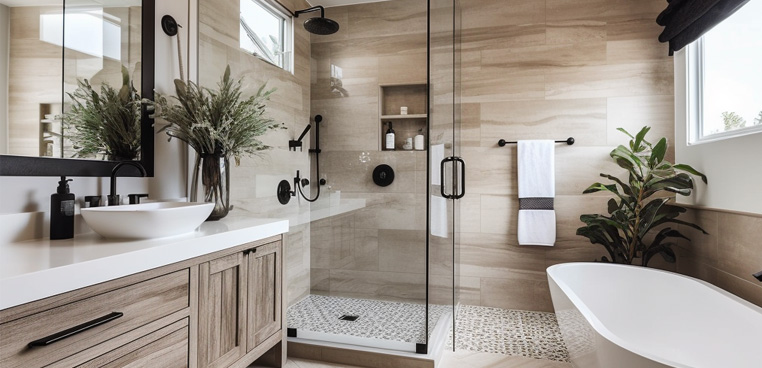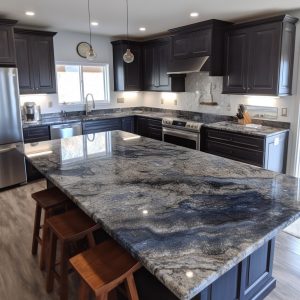
Maximizing Natural Lighting in Kitchen and Bath Remodels
 Bringing abundant natural light into your kitchen or bathroom remodel might seem challenging, but it can pay huge dividends for both aesthetics and functionality.
Bringing abundant natural light into your kitchen or bathroom remodel might seem challenging, but it can pay huge dividends for both aesthetics and functionality.
Thoughtfully designed and positioned windows, skylights, solar tubes and architectural elements like sun shelves allow you to harvest free, ecologically-sound sunshine to make these important living spaces brighter, more uplifting, and more energy efficient.
When remodeling your kitchen or bathroom, leveraging natural daylight should be a key priority. Abundant natural light lends both beauty and functionality.
This comprehensive guide covers creative remodeling techniques to draw ample illumination from the sky into any kitchen or bath layout. Learn design strategies, material selections, specialty additions and smart integrations that transform ordinary enclosed rooms into sun-drenched oases.
Careful planning ensures your reimagined kitchen or bath gets drenched with radiant natural light from morning to evening, lending beauty, visibility for tasks, and vital health benefits.
Benefits of Natural Lighting
Incorporating natural light provides advantages:
- Saves on energy costs. Minimizes use of artificial lighting during day.
- Creates cheerful, uplifting ambiance. Natural light has positive psychological benefits.
- Enhances visibility for tasks like food prep and grooming. Bright, uniform daylight reduces eye strain.
- Allows plants and greenery to thrive with sufficient sunlight.
- Provides vitamin D essential for health, mood, immunity and bone strength.
- Highlights true colors, textures and details compared to artificial sources.
- Matches the rhythms of natural circadian cycles and sleep wake patterns.
Thoughtfully planned windows and skylights make the most of these rewards.
Evaluate Existing Conditions and Constraints
Assess current conditions to identify sunlight challenges and opportunities:
- Note number, size, placement, and condition of all existing windows and skylights. Measure glass area.
- Identify primary task zones needing ample natural light like counters, sinks, and ranges.
- Document how much direct sunlight currently enters the space at different times of day. Track reflections and shadows.
- Look for aspects limiting light like small windows, obstructions, overhangs, and paint colors.
- Consider adjacent room additions that could increase window or skylight potential.
The assessment informs strategic changes to maximize natural light gain.
Optimize Window Placement
Window placement profoundly affects light distribution:
- South facing windows get the most light overall. East facing receive morning light. West get afternoon/evening light.
- Prioritize task zones along walls. Give sinks and preparation areas first priority for direct light.
- Align major windows across from each other to create bright light corridors.
- Add complementary windows facing different directions for balanced illumination throughout the day.
- Avoid too many small scattered windows. Consolidate into larger formats for amplified brightness.
Layout changes may be warranted to enable ideal positioning.
Choose the Optimal Window Styles
Beyond placement, window type influences lighting:
- Opt for double hung, awning or casement styles that allow ventilation. Fixed windows lack air flow.
- Frame windows fully to the ceiling with transom windows above to draw light up into the space.
- Select panoramic formats to reduce segmented dark spaces between windows.
- Favor taller windows. They admit more uniform light deeper into a room’s core.
- Where possible, extend windows fully to floor level as well for illumination of lower surfaces.
- Ensure windows meet ENERGY STAR standards for solar heat gain coefficient and U-factors for efficiency.
The right styles brighten while offering ventilation and visual appeal.
Select Window Glass to Balance Light and Energy Use
Glass choices further tune lighting performance:
- Double or triple insulated glass provides better insulation with minimal energy loss.
- Low-emissivity coatings on glass reduce UV and heat gain maintaining cooler indoor temps.
- Lighter glass tints improve visibility while minimizing glare and heat. Dark tints look opaque.
- Smart glass options like electrochromic or thermochromic glass can intelligently adjust tint.
- Consider vacuum insulated glass for maximum insulation capacity in cold climates.
The optimal glass transmits abundant light without compromising efficiency.
Leverage Skylights for Overhead Sunlight
Skylights funnel sunshine from above:
- Place centralized away from other light sources for well-distributed ambient illumination.
- Opt for tube skylights to feed sunlight into interior core rooms distant from exterior walls.
- On vaulted ceilings, align flush mounted skylights directly overhead to wash ceilings with light.
- Look for models with ventilation capabilities to prevent overheating on summer days.
- Select skylights with widths of at least 2 to 3 feet for substantial light delivery.
Skylights add unique overhead glow others light sources can’t replicate.
Include Sun Tunnels or Light Wells
Sun tunnels pipe light through ceilings from roof domes:
- Position sun tunnel domes above areas needing illumination if roof allows.
- For windowless interior rooms, sun tunnels amplify ambient daylight.
- Opt for rigid tunnel material with high reflectivity like aluminum over plastic.
- Include dual dome models that provide supplemental artificial light when needed.
- Similarly, interior light wells dug adjacent to basement windows guide light into lower levels.
These devices redirect sunlight to challenging areas.
Enhance Natural Light Quality
Beyond adding windows and skylights, design choices affect light character:
- Choose light, reflective paint colors like soft whites and pastels to maximize brightness.
- Use semi-gloss or high-gloss finishes on surfaces like cabinets to amplify reflectivity.
- Add mirrors strategically to bounce and spread sunlight to darker corners.
- Ensure windows and skylights have overhangs to control glare and heat gain during summer peak hours.
- Diffuse intense direct beam daylight with translucent window treatments. Avoid blackout shades.
- Specify Energy Star certified fixtures with quality CRI ratings to supplement natural light nicely.
Design adaptations make natural light welcoming while reducing harshness.
Combine Lighting and Windows for Balance
Integrate ample task lighting to balance shadows:
- Add recessed LED lighting to prime work areas around windows.
- Include under cabinet lighting to illuminate tasks without competing with outside views.
- Use accent lighting in areas sunlight can’t reach, like display nooks or dining spaces.
- Layer ambient, task and accent lighting to create ideal illuminance for all needs.
- Install dimmers to adjust artificial light levels seamlessly based on available sun.
With smart lighting combinations, no area gets left underlit or dim.
Introduce Sunlight with Specialty Design Choices
Unique architectural elements lend added sunlight:
- Clerestory windows just below ceilings draw light deep into rooms.
- Translucent panels on ceilings or upper walls filter radiant natural light.
- Sun shelves or light shelves made of glass or metal reflect additional light without glare.
- Light tubes and mirrored ducts pipe light through walls from windows to darker spaces.
- Solar tubes with small exterior roof domes funnel light into otherwise dark inner rooms.
- Interior glass atriums, sunrooms or greenhouses adjacent to main living areas share sunshine.
Custom touches tailored to your space overcome challenging configurations.
Make Bathroom Skylights Part of Your Spa Retreat
Bathrooms benefit greatly from overhead sunlight:
- Flush circular skylights over stand alone showers or tubs create a bright spa aesthetic.
- Tubular skylights amplified with reflective tubes distribute ample ambient glow to windowless baths.
- Venting skylights clear humidity while providing illumination.
- Pair electric lighting on dimmers with skylights for total ambient control.
Bathing in natural light is restorative while also aiding important grooming tasks.
Kitchen Skylights for Cooking and Gathering
Skylights work beautifully in kitchens:
- Position skylights correctly over prep zones, islands and dining areas. Measure carefully.
- Large rectangular or square formats provide the most uniform overall light distribution.
- Tubular skylights help interior kitchens borrow light from adjoining sunnier rooms.
- Complement bay window seat areas with skylights to make them fully useable during daytime hours.
- Install a remote controlled retractable skylight for controlling ventilation and adjustable sunlight.
Kitchen skylights make meal prep, cooking and cleanup more pleasurable.
Using Light Shelves and Reflectors
Light shelves bounce indirect light deeper into rooms:
- Install above eye level windows to amplify illumination reaching back walls.
- Useful for rooms with limited windows like galley kitchens.
- Angle reflective panels to direct sunlight onto ceilings for diffuse ambient fill.
Similarly, domed plastic light refractors attach above windows to scatter incoming light wider into a space. These devices maximize the footcandles gained from existing windows.
Sun Tracking Skylights
Some advanced skylights dynamically track the sun’s movement to capture more direct light:
- Motorized light sensing lenses adjust angle of opening to follow the sun across the sky.
- Photovoltaic sensors detect changing conditions and move skylight covers accordingly.
- Remote controls allow manual optimization of the lens angle as needed.
- Models with dual-axis tracking optimize both vertical and lateral angles continuously.
Though expensive, for north facing rooms with static skylights these devices draw in ample additional sunlight.
The Best Lighting for Circadian Health
Beyond illumination, natural light impacts sleep and alertness:
- Exposure to bright blue-toned morning light sets your circadian rhythm properly.
- Avoid very warm tinted light sources that suppress stimulating daylight.
- Let in bright sunlight early to energize and enhance focus.
- Reduce blue light exposure in the evening for sounder sleep. Smart bulbs can shift tones.
Leveraging natural light patterns aligns your biology resulting in improved health, mood and performance.
Summary
By thoughtfully incorporating more natural light into your kitchen or bath remodel using solar positioning, architectural additions and intelligent design, you can create bright inviting living spaces that uplift mood and supplement electric lighting.
Be sure to collaborate with your architect or designer to integrate natural illumination in a holistic manner tailored to your unique space. Harnessing free abundant sunlight provides the healthiest, most beautiful and sustainable kitchen and bathroom lighting solution.
